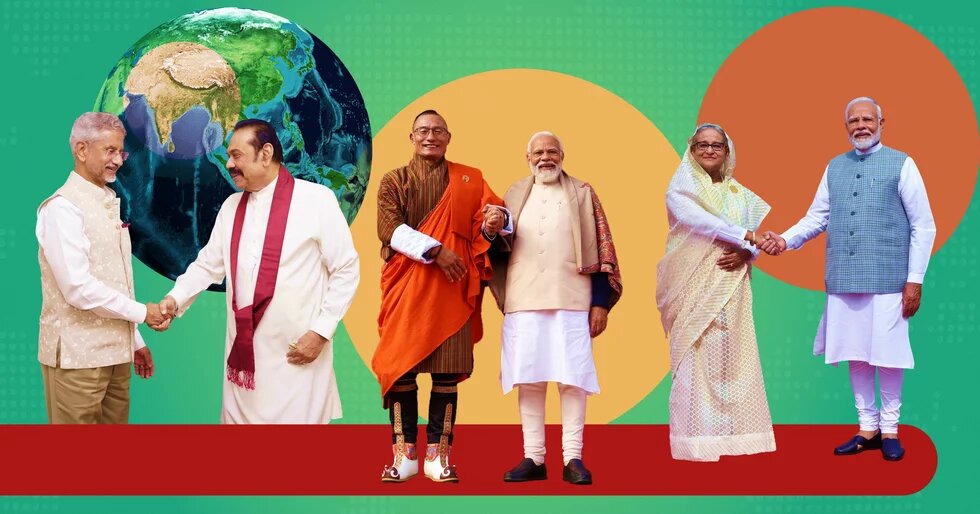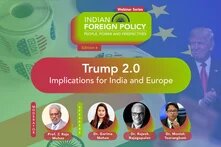The renewed focus on South Asia, which began in the previous regime under Prime Minister Narendra Modi, is likely to be a foreign policy priority for the recently sworn-in National Democratic Alliance government also led by Modi, especially in face of the growing influence of China in the region.

For the recently sworn-in National Democratic Alliance (NDA) government in New Delhi led by Prime Minister Narendra Modi, one of the major foreign policy priorities is likely to be South Asia. As India aspires to play a global role, it recognises that its path to the global role must go through the neighbourhood.
New Delhi’s renewed focus on South Asia started during the previous tenure of Prime Minister Modi and is driven by several interrelated factors. The article first examines these factors and then outlines the key features of India’s regional policy.
The new geopolitical context in South Asia
The emergence of the Indo-Pacific as a prominent region in the world and its growing interconnectedness with South Asia makes it clear that India’s ability to play a larger role in the Indo-Pacific will be shaped significantly by its relationship with its neighbours. India has so far kept South Asia away from its larger Indo-Pacific strategy, which is characterised by proactive minilateralism, openness to free trade, supply chain initiatives, and conversations and consultations on a range of issues. Its South Asia policy, in contrast, continues to suffer from inertia and lack of creativity. Moreover, New Delhi has yet to conceptually or materially bridge its Indo-Pacific strategy with its South Asia strategy.
Secondly, India’s sphere of influence, which has remained strong over South Asia since independence, is on a decline. China’s trade, connectivity, political, military and soft power engagement with each South Asian country has increased manifold over the past decade. As a result, despite its increasing global prominence, India’s influence is paradoxically weakening in South Asia. India’s power and influence in the region, which were considerable during the Cold War in comparison to those of China, has drastically come down now.
A key reason for India’s depleting power in the region is the rise of China. Although India is more powerful than it had ever been in nearly two centuries, yet comparatively speaking, its power is the weakest ever in history vis-à-vis China. Confronted with the prospect of a rising superpower next door for the first time, India is facing stiff geopolitical competition for its influence in South Asia. China’s rise will, therefore, mean that India may no longer be the most consequential power in the region.
Beijing seems to be in no mood to reset its ties with New Delhi. The Modi-led government started on an optimistic note with an invitation to key neighbouring heads of government for its swearing-in and sent signals to China, through various statements, that it is willing to resolve contentious issues for normalising the ties. While the neighbourhood nations responded positively to India’s calls for strengthening the regional partnership, it would not be inaccurate to say that China did not respond to India’s calls for the normalisation of ties, perhaps indicating a strained future relationship between the two sides.
The third broader context that will shape India’s regional policy is the gradually intensifying involvement of powerful nations in South Asia. While China’s assertiveness in the region is well known, what is less noticed is Russia’s increasing engagement with countries such as Bangladesh, Myanmar and Pakistan. The United States is re-engaging Pakistan, has come around to accepting the Sheikh Hasina regime in Bangladesh, maintaining contacts with the Taliban and has not been increasing its pressure on the Myanmar junta. States like Japan and Germany are engaged in a trilateral development cooperation with India in the region, indirectly providing an alternative to China.
Given this context, the following factors are likely to shape India’s South Asia policy under Modi 3.0.
Continuing course correction
If a high dose of Hindutva ideology and aggressiveness characterised New Delhi’s diplomacy in its engagement with its neighbours during Modi 1.0 from 2014 to 2019, India’s neighbourhood policy under Modi 2.0 was marked by a more careful and well-calibrated approach, which led to several well thought-out policies in its relationship with most of the region, with a deep desire to win back the neighbours. During Modi 1.0, relations with Nepal, Bangladesh and Sri Lanka (as well as the attitude towards the Taliban until they overran Kabul in August 2021), for instance, were complicated due to ideological overtones and aggressive policies. The intervention in Kathmandu’s Constitution-making process and the subsequent (undeclared) blockade of Nepal, irking the Bangladeshis with offensive references and attempting to be the kingmaker in the Sri Lankan elections, among others, proved futile. Such an ‘either you are with us or against us’ attitude prompted many of India’s neighbours to tilt in favour of China, giving it a free pass, at least to some extent, into India’s traditional sphere of influence.
This unmissable course correction we witnessed under Modi 2.0 is likely to become even sharper under Modi 3.0. The invitation extended to the regional leadership for the swearing-in of the NDA government is an indication. But there are inherent limits to this course correction considering the structural factors that have overtaken the bilateral dynamics of India’s relations with each of its neighbours.
Dealing with the China challenge
New Delhi’s course correction towards the neighbourhood has also come about as a result of the rise of China and its attempts to displace India from its traditional primacy in the region. China is India’s most consequential neighbour for three reasons: It is India’s second biggest trading partner, the power differential between the two sides has tilted in China’s favour in a big way and the two sides have a restive and unresolved border, which has led to confrontations in the past.
However, New Delhi also realises that balancing the growing Chinese power is not going to be easy for the following reasons, among others. First, an open and direct balancing of China could provoke aggressive responses from that country, including more potential aggression on the border. Second, given the domestic political scenario in India, no ruling party would want a situation on the border that it can’t afford to lose. And finally, a military escalation or aggravation of tensions would have negative implications for trade with China. Even though the balance of trade favours China, the Indian business community’s major dependencies on trade with China might prompt the government to reconsider its policy towards China.
This doesn’t mean that New Delhi will not balance Chinese power; it will do so indirectly and subtly. New Delhi’s strategies towards China are likely to involve bringing more like-minded powers to the South Asian region to check China’s potential dominance of the region. India’s partners might also recognise the importance of this strategy given that a China-dominated South Asia could pose potential challenges to the Indo-Pacific strategies of India and its global partners. In that sense, a second strategy that India might use to balance China would be to expand its Indo-Pacific engagement with the objective of linking the geopolitics of South Asia with that of the Indo-Pacific.
Uncertain Pakistan policy
What is perhaps most uncertain at this point is the Pakistan policy of the NDA government. If we were to carefully examine the India–Pakistan relations over the past two decades, we can observe two distinct and divergent formats in which the relationship was managed. The first one, which lasted from 2004 to 2007, took the form of a grand comprehensive dialogue accompanied by confidence-building measures, people-to-people contacts, summit meetings and backchannel dialogues, all with the objective of conflict resolution between the two countries. This pretty much ended with the Mumbai terror attacks of 2008.
The second format is the current one, starting with the ceasefire agreement of 2021, which came in the wake of a rather acrimonious relationship after the 2019 Indian decisions on Kashmir. The current format is minimalist in nature, with no people-to-people visits or contacts, no high commissioners on either side, no summit meetings and no attempt to address all issues between the two sides. This relationship, mostly carried out through the backchannel, focused on specific issues and aimed at conflict management, hardly attempts conflict resolution.
New Delhi may have found a certain comfort in dealing with Pakistan using the new format, especially after experiencing a strong Pakistan fatigue with the older format yielding little sustainable outcome.
More importantly, it appears that there is a visible absence of incentives for New Delhi to engage in a dialogue with Pakistan. Moreover, bigger strategic priorities such as China and the Indo-Pacific may have occupied New Delhi’s attention. Given the current state of the relationship, India’s focus will remain on conflict management rather than conflict resolution with Pakistan.
Other features
Three more potential features of India’s foreign policy under the NDA government are worth highlighting. India’s decision to open communication channels with the military government in Myanmar is likely to continue in line with its policy of engaging whoever holds power in a country. Likewise, New Delhi’s engagement with the Taliban government in Afghanistan is expected to grow gradually. While India’s interests in Afghanistan are largely indirect and geopolitical due to the Pakistan factor and driven by the possibility of a potential spillover of terrorism, India has more direct interests in Myanmar. Its geographical proximity to India and its significance in New Delhi’s ‘Act East’ policy make the conflict-ridden country important for India’s economic, political and geopolitical interests.
Secondly, despite the new enthusiasm in New Delhi to reach out to the neighbourhood, it is doubtful that it would seek to promote regionalism in South Asia, especially through the South Asian Association for Regional Cooperation (SAARC) and its institutional frameworks. New Delhi appears to think that SAARC as a hyper-political platform may not really lead to any desirable outcomes and that it will only end up shrinking India’s power and influence in the region.
Although several features of a potential Indian foreign policy towards the region under the new government have been highlighted here, India’s broad regional policy is likely to have two engines: course correction and bringing the region within the ambit of the larger Indo-Pacific balance of power construct.
Disclaimer:
This article was prepared with the support of the Heinrich Böll Stiftung. The views and analysis contained in the publication are those of the author and do not necessarily represent the views of the foundation. Heinrich Böll Stiftung will be excluded from any liability claims against copyright breaches, graphics, photographs/images, sound document and texts used in this publication. The author is solely responsible for the correctness, completeness and for the quality of information provided.


